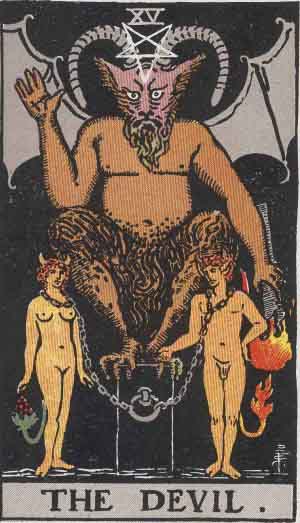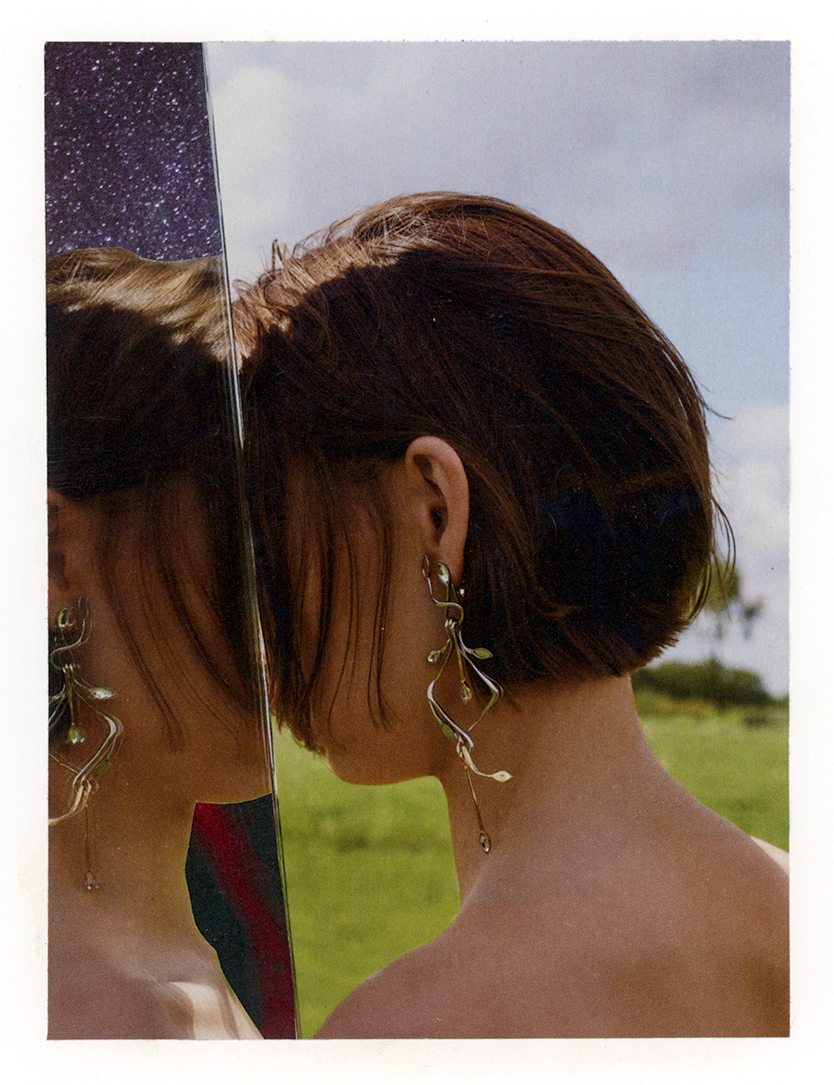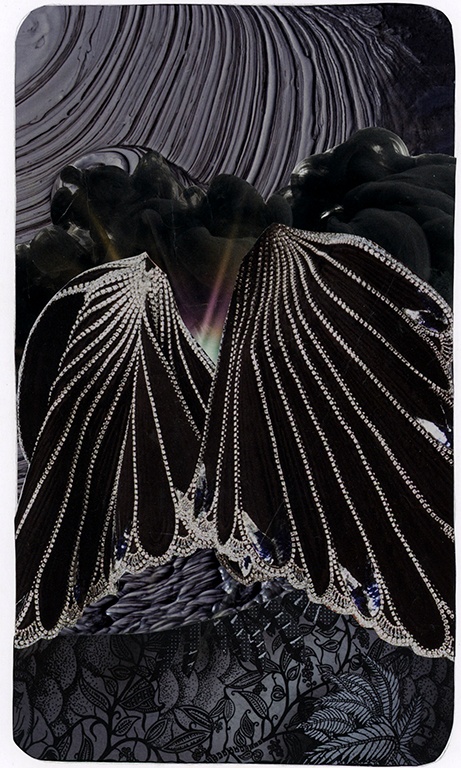As I’ve written before, my goal with this tarot deck is to remove, to the extent possible, feudalism, colonialism, gender hierarchies, and references to do with Abrahamic religions. Sometimes meeting these goals in the artwork is easy, other times it’s very hard.
The Devil card is one of those challenges I’ve been sitting with for a while. It’s card 15 in the Major Arcana. I don’t really do much with numerology so idk if it has a numerological significance or not.
Here is the card’s design by Pamela Colman Smith for the Ryder-Waite-Smith deck.

The Devil sits on a perch, and the creature has goat horns, a cat-like face, bat wings, human torso and arms, goat legs, and chicken feet. A pentacle emanates from its forehead. One hand holds a lowered torch and the other is making a hand gesture that I’ll say more about momentarily. Chained to its perch are two figures that look like humans but they have horns and tails. One’s tail is engulfed in flame, and the other’s looks like a flowering vine.
I personally have too much personal baggage around the figure of the Devil to really engage deeply with the typical interpretations of this card. (I haven’t yet written about how obsessed Jehovah’s Witnesses are with Satan, but I will.) The traditional interpretations are exactly what you’d expect: violence, force, predestination, weakness, materialism, complacency.
I learned from this excellent episode of the podcast Moonbeaming episode “Sympathy for the Devil” that the gesture the devil figure is making is “ש” sign used by Jewish rabbis to signify “Shalom,” a greeting of peace and harmony. To assign this gesture to the Devil with its typical interpretation is appropriative and antisemitic.
More contemporary interpretations of the card temper the older moralizing messages by framing the card as a shadow side, negative forces that are holding you back, believing that someone or something has power over you when they don’t. As I was considering how to approach this card, I was thinking about calling it The Shadow. I made this collage a while back for a different project and it was a starting point for me.

As I kept thinking, I just really didn’t want to frame my or your shadow self as the devil! I’ve personally been doing a lot of shadow work on my own and in therapy and for those of us who have trauma in our past, it’s necessary to understand and befriend those shadowy traits in order to fully experience healing.
Thinking about shadow work did get me thinking about what is scary about the shadows we encounter internally and for me, at least, it’s that you’re entering the unknown. You don’t know what you’ll find or remember. It may hurt tremendously before the healing can begin.
Since the setting for my major arcana cards is the celestial realm, I then started thinking about black holes—the ultimate unknown. Gravity so powerful even light can’t return. It’s a one way ticket but to where? We can’t know, unless we experience it.
A black hole was a really good and fertile thought experiment to explore. Black holes are amoral—they are neither evil nor good, they just exist. They are a mysterious force of nature that literally does not have a care for anything that crosses its path; they consume all. They are incomprehensible by human thought, yet we are obsessed with them.
I liked this direction, but “black hole” still seemed to have some frightening connotations for me. You can’t return from it. What would pulling the Black Hole card mean????? To me, it would lead to thoughts of irreversible decisions; being too far gone for help; futility in the face of an incomprehensible external force. I definitely don’t want that to be the message of any card in my deck.
Two books I read over the last month helped me get from Black Hole to Abyss: Underland: A Deep Time Journey by Robert Macfarlane and The Origin of Satan by Elaine Pagels. Both authors introduce the abyss as a powerful and potentially positive place to contemplate and experience.
I want to write a full book review of each of these because I found them each fascinating. But here I’ll just share a few quotes that informed my thinking for The Abyss card.
Underland is a poetic travelogue of voyages under the earth’s surface. The author explores deep caves, mines, subterranean astronomical observatories, the extensive city under Paris, underground rivers, and the deep meltwater crevasses of glaciers. In addition to the description of his travels, he references literature, theology, history, and metaphysics. Here are some quotes from Underland (I read it on Kindle so I don’t have page numbers, sorry!)
- “Into the underland we have long placed that which we fear and wish to lose, and that which we love and wish to save.”
- “Deliberately to place something in the underland is almost always a strategy to shield it from easy view.”
- “[The] Saami [indigenous population of northern Scandanavia] vision of the underland as a perfect inversion of the human realm, with the ground always the mirror-line, such that ‘the feet of the dead, who must walk upside down, touch those of the living, who stand upright.’”
- “Portals give access to their extensive underland”
- “To hear the breath of the birth of the universe, you must come below ground”
- “The void migrates to the surface”
- “beckonings into and warnings of the void”
- “I realize I have stopped, have been stopped by the void and the glimpse into the depths that it gives or demands.”
I did like The Void as an alternate title, but again I think that brings up too many connotations of annihilation, nothingness, nihilism. The Abyss, as described by Macfarlane, is very much alive, even if only in our imaginations.
My other ideas around the concept of The Abyss came from a very surprising source—early gnostic Christian writings.
I checked out The Origin of Satan hoping to find some historical context to help with making sense of the Devil card and what role this should play in my own deck. This book was very interesting to me because, in the character of many scholarly books, the sensational title didn’t really tell me what I was in for once I started reading. The author characterizes the interactions between the early Jesus movement (i.e., before Constantine converted to Christianity in the 4th century) and Jewish, pagan, and heretic belief systems. I will reference this book again in a future post because I highlighted so many things that echo forward into the Jehovah’s Witness belief system.
Pagels contextualizes the New Testament character of Satan as one that wholly emerged from the context of early followers of Jesus negotiating their place in society. It’s fascinating.
This passage near the end of the book resonates with me and why it felt important to transform the meaning of this card. Its legacy is ubiquitous.
- “Many religious people who no longer believe in Satan, along with countless others who do not identify with any religious tradition, nevertheless are influenced by this cultural legacy whenever they perceive social and political conflict in terms of the forces of good contending against the forces of evil in the world. Although Karl Marx’s extreme and resolutely materialist version of this apocalyptic vision is now nearly defunct, a secularized version of it underlies many social and political movements in Western culture, both religious and antireligious.”
In an early chapter of the book (sorry no page numbers! I read almost everything on my ereader!), Pagels starts with the very name Satan. It was not always a proper name, but rather in the Hebrew tradition and language, the satan was a role assigned by god.
- “[T]his supernatural character, the satan, who, by God’s own order or permission, blocks or opposes human plans and desires. But this messenger is not necessarily malevolent. God sends him, like the angel of death, to perform a specific task, although one that human beings may not appreciate; as the literary scholar Neil Forsyth says of the satan, “If the path is bad, an obstruction is good.” Thus the satan may simply have been sent by the Lord to protect a person from worse harm.”
- “[T]he satan terrifies and harms a person but, like the angel of death, remains an angel, a member of the heavenly court, God’s obedient servant.”
This was exactly the kind of context I was looking for to help me reframe the very core of The Devil card. Something that slows a process down. Maybe the people affected don’t like it but this is not the evil force of the universe that The Devil typically signifies. Nor does it moralize natural human desires as sinful.
Later in her study, Pagels explores the beliefs of the Gnostic Christians, and this is really where my interest was piqued.
- “They taught, for example, that the creator God described in Genesis is not the only God, as most Christians believe—nor is he the malevolent, degraded chief of the fallen angels, as the radicals imagine. According to Valentinus, he is an anthropomorphic image of the true divine Source underlying all being, the ineffable, indescribable source Valentinus calls ‘the depth,’ or ‘the abyss.’”
- “When Valentinus does invoke images for that Source, he describes it as essentially dynamic and dyadic, the divine ‘Father of all’ and ‘Mother of all.’”
- “But the author of [The Gospel of] Philip wants to throw away all the lists of good things and bad things—lists that constitute the basis of traditional Christian morality. For, this author suggests, what we identify as opposites—’light and dark, life and death, good and evil’—are in reality pairs of interdependent terms in which each implies the other.”
- “Some, the author says, “go down in the water [of baptism] and come up without receiving anything,” but nonetheless such a person says, “I am a Christian.” For such people, according to Philip, the name “Christian” is only a promise of what they may yet receive in the future. For others, however, baptism becomes a moment of transformation: ‘Thus it is when one experiences a mystery.’”

This is my major arcana card 15 – The Abyss.
From passages like those I’ve cited, I gathered the following thoughts
- The Abyss is sacred
- The Abyss as an idea is mythic in its significance and is engrained in our DNA
- The Abyss is mystery, but not necessarily a place of fear or danger
- The Abyss is a Source
- Divinity lives in The Abyss
- The Dark is not inherently bad or frightening; it can be instructive, a teacher, a place of growth
- The Abyss is a sacred mystery and brings about transformation
What are your interpretations of The Devil and The Abyss? It’s all so subjective, I’d love to know your takes.










First off- I was reading all this and loving the journey of your creative process and research… then I got to the card image and literally GASPED at how gorgeous it is. Absolutely fit everything you were describing.
I love the idea of The Abyss for this card because the unknown is unknowable- is it scary or are we just afraid? Is the devil of the original card actually holding people back, or are they holding themselves back in fear? I am bookmarking this post to come back to.
I really liked the podcast I linked to for more discussion of the Devil as the Devil. You’d probably enjoy taking that in passively.